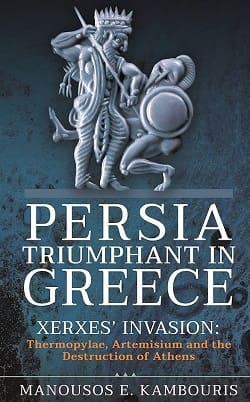Author: Manousos E. Kambouris
Hardback (7.1×10.0 inches). 226 pages. 2022.
Subtitle: Thermopylae, Artemisium and the Destruction of Athens
The second book in a trilogy examines the Persian invasion of Greece.
This enlightening examination and comparison of ancient sources discusses the composition of the Persian Army, from its loss at Marathon to its invasion under Xerxes. Of particular note is an idea that the ancient numbers may not have been exaggerations as conventional wisdom insists. A significant amount of time is spent on logistics and comparisons of other Persian recruitment drives and levies. The 1.8 million Persian figure may include a number of other bodies, not necessarily main combatants.
On the flip side, his analysis of Spartan and Greek numbers at Thermopylae may indicate more Spartans than the 300 mentioned. As an example, his asserts the Persian Immortal unit of 10,000 troops contained 1,000 elite troops and 9,000 veteran troops. Likewise, he asserts the “Spartans” were 1,000 Lacedaimonians in number, of which 300 were the elite King’s bodyguard (p75).
The initial battle for the pass was a Persian attack off the march with light troops. It was repulsed. Another attack, reinforced by those 1,000 elite Immortals, was also repulsed. The tactics used by both sides get an extensive analysis. The discussion about what constitutes the “wall” (or gates) at the pass is fascinating.
The Spartan strike against Xerxes himself is an interesting special operations move taken in part out of desperation. The attrition in Spartan men and weaponry is well told.
The ship tactics, fleet strategy, and numerical analysis are quite good.
One goofy description that should have been edited out: comparing Thermopylae terrain to the “Doors of Mordor” from Lord of the Rings (p71). Ah….no. You might as well speculate about the use of a Rhinoceros from the movie 300.
One odd language quirk: comparing the stand at Thermopylae with the Texan stand at “Los Alamos.” I get the Spanish nomenclature, but for the American audience, “The Alamo” will do fine. The sentiment about being a delaying action until mobilization could occur is indeed apt.
One typo (p144): “Tthe” has an extra letter t.
The book contains three color photos, 22 color illustrations, and 11 color maps. The maps and most images are all rudimentary, and that’s being kind, but get the points across.
You may or may not agree with his depiction and analysis of the forces and Battle of Thermopylae, but it is well presented and well reasoned. The grappling of ancient sources, numbers, and descriptions makes you think, and rethink, how this famous battle played out. I gave a positive review of his first book in the trilogy: The Rise of Persia And The First Greco-Persian Wars. The same goes for this second book. I eagerly await the third.
Enjoyed it.
–Reviewed by Russ Lockwood










